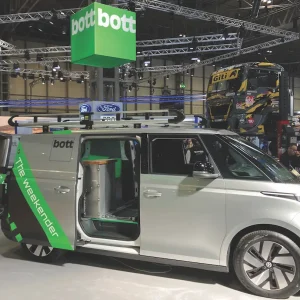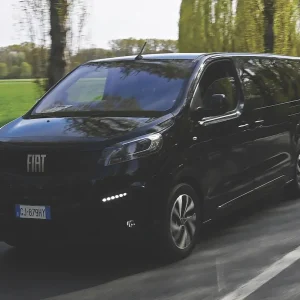With the anti-diesel juggernaut gathering pace and with some of our cities threatening to become no-go zones for the fuel that powers the vast majority of the UK’s light commercial vehicles, the search is on for viable alternatives.
Petrol-powered vans may start to sell in bigger numbers again but it seems inevitable that so-called ‘alternative fuels’ will become more prominent and be expected to provide the long-term solutions.
Two major manufacturers, Volkswagen and Renault, are exploring different technologies to improve the environmental credentials of their light vans. Volkswagen has developed a new version of its Caddy powered by compressed natural gas (CNG). Badged the Caddy TGI, the model is based on the 1.4 TSI petrol Caddy. As is VW’s wont, it is testing the water before leaping in and committing to a commercial roll-out.
As a spokeswoman put it: “Although a RHD (right-hand drive) version is not currently on the cards, we hope fleets will see it as an alternative, which could be right for them in terms of range, cost and qualities.”
The brand takes a similar approach to electric vans – it displayed an e-Load-up city van prototype at the CV Show in April but is gauging customer feedback before bringing it to market. One vision Volkswagen has for CNG is as “a bridge to electro-mobility”.
The manufacturer did, in fact, supply a limited number of CNG Caddys to the UK until July 2014, according to the Low Carbon Vehicle Partnership’s Low Emission Van Guide. Leeds City Council, which already had gas refuelling facilities installed for its refuse vehicles, took on seven bi-fuel Caddys, which run on CNG with a small petrol reserve tank, to cover domestic repair and maintenance work at households in the city.
Although CNG, like petrol and diesel, is a fossil fuel, the environmental benefit comes from the fact that it is available as biomethane, which is produced from organic waste, is renewable and sustainable, and can be directly used to power CNG vehicles. Most importantly for air quality, there are no NOx emissions.
Having driven the Caddy TGI in Germany, we can attest that it is remarkably similar to a regular petrol van, and certainly quieter than one with a diesel engine. A disadvantage is that the weight of the tanks used to store the CNG in the van cut the payload by about 10%, although load space is unaffected.
Volkswagen claimed the TGI Caddy in manual mode has a range of 391 miles on CNG with CO2 emissions of 112g/km, with the LWB Caddy Maxi delivering 534 miles and 116g/km of CO2. With the six-speed DSG dual clutch we drove CO2 goes to 123g/km and 126g/km, respectively.
But from well to wheel, VW claimed fuel life-cycle savings on CO2 of 25% on CNG rising to 80% with biomethane. In case the natural gas range is insufficient, the TGI comes with a 13-litre petrol reserve tank in both Caddy and Caddy Maxi modes. Otherwise, petrol is just used to start the engine.
The Caddy TGI went on sale in Germany and Italy in May this year with prices in Germany starting at about £18,500, excluding VAT. Both these markets have established fuelling networks, unlike the UK.

The newest Renault Z.E Kangoo takes six hours to charge fully
In contrast to Volkswagen, Renault has not taken a softly-softly approach to alternative fuels and has long nailed its colours to the mast of electric vehicle technology. At the Brussels motor show in January the brand revealed its first plug-in large van – the Z.E. Master will come to market in the first quarter of 2018. Designed for last-mile deliveries, it will have a real world range of 75 miles, Renault claimed, a 1,000kg payload – 400kg less than the diesel can carry – and a loadspace of 13.0m3.
It is the Z.E. Kangoo light van, however, that established the manufacturer as a pioneer in EVs, and it has refined the model this year with new 33kW batteries that have increased range by 50% to 168 miles on the New European Driving Cycle (NEDC), or 124 miles under real-world conditions.
We drove the upgraded Z.E. Kangoo in left-hand drive mode and found that much of the previous harshness in acceleration and braking has been eradicated to be replaced by far smoother driving characteristics, although it is still possible to keep use of the foot brake to a minimum when slowing down just by releasing the throttle.
The van had a 250kg load in the back, which helped to improve the ride by tempering its more extreme EV tendencies without diminishing the load-lugging ability of the 60hp and 225rpm maximum torque available. Full battery charging time has been reduced from eight to six hours, but rapid charging is not offered as the brand claims it reduces the lifespan of the battery. However, Renault adds that a one-hour charge can top-up the range with an extra 22 miles.
The brand has added a heat pump to the new Kangoo Z.E. that operates through the air-conditioning system without significantly reducing range during cold weather through overworking electrical components, according to the manufacturer. It admits, however, that this will not be a standard fit.
Launched in 2011, the Kangoo Z.E. has been Europe’s best-selling electric van for six years. Renault claimed that a quarter of the 120,000 electric vans on European roads bear its badge. Of the extended range, Jean-Louis Weidemann, global sales and marketing boss for small vans, said: “It can be driven all day and make two rounds of deliveries: morning and afternoon.”
Renault has introduced a smartphone-based app, ZE Pass, that customers can use to pay for recharging, and an online tool for fleets, ZE Connect Pro, that fleet managers can use to check the van’s battery charge levels when on the road or at base. ZE Trip, meanwhile, uses the van’s R-Link navigation system to locate charge points.
Renault claims a payload of 650kg for the Z.E. Kangoo and the long-wheelbase Z.E. Maxi version and maximum load volumes of 3.5m3 and 4.6m3 respectively, which correspond to the diesel equivalents.
At the end of the year the brand says it will launch a new version of the Z.E. Kangoo Maxi with an expanded load volume of 6.0m3 to meet the growing demand for parcel delivery operations in cities. This bodystyle will only be offered on electric vans, explained Weidemann, because in the diesel derivative it would cross over with the Trafic medium van.
Weidemann emphasised the enhanced practicality of the Z.E. Kangoo line-up with its extended range. “Customers are pragmatic,” he explained. “They will only buy what they need. But the peak [maximum] usage possibility is a must – they need more range for work.”
He claimed the Z.E. can now satisfy 85% of the light van market. Weidemann argued demand for used electric vans will grow because of their guaranteed exemption from congestion zones. He added Renault will offer a lower rental package for the second user on batteries as well as maintaining a full purchase offer.
The Z.E. Kangoo will go on sale in September with a starting price of £14,200 plus £50 month battery rental, or for an outright purchase for £17,800. Air-conditioning with the heat pump costs £965. All prices exclude VAT.





